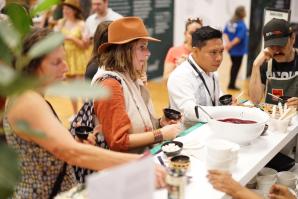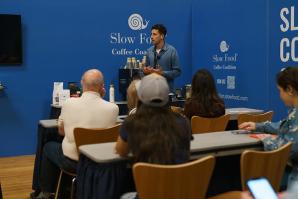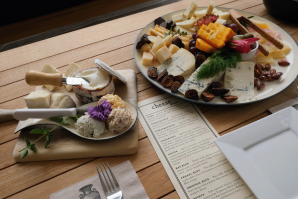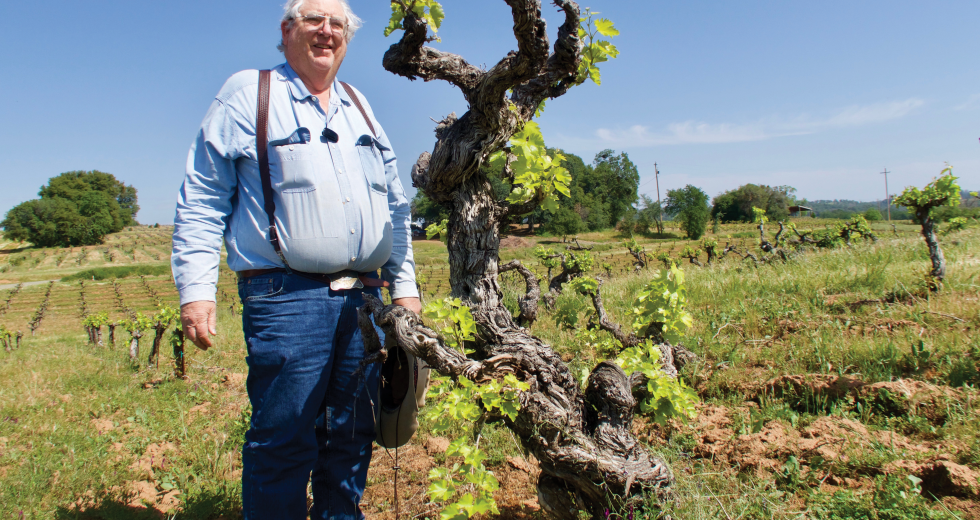Sacramento hosted the first full-scale Terra Madre Americas last week, showcasing the Capital Region as an epicenter of the continent’s slow food and agriculture. The event, which attracted an estimated 155,000-165,000 attendees from around the world, also offered an opportunity to shine a spotlight on California’s wine industry. However, pours at the three-day event ran well over the borders of the state. Winemakers from Mexico, South America and beyond took part in panels revealing the often-overlooked regions of the Americas.
A number of these panels were hosted by the Slow Wine Coalition, which Terra Madre President Edward Mukiibi calls “a coalition of winemakers and people who are concerned about good, clean, and fair wine — not only wine that tastes good, not only wine that gives you pleasure in the glass, but also raises issues of social equity around vineyards and issues of environmental impact of wine production.” He adds that the coalition’s panels intentionally paired tastings with social and historical education. “When there are wine vendors here, they are carefully selected for these social, environmental, and political issues around wine production,” he says.
Here are a few highlights from the Slow Wine Coalition’s panels, and takeaways that may inform the Capital Region’s small winemakers.
Friday: Get to Know Mexican Wines
Look just south of the border and you’ll find some of the fastest-growing wine regions in the Americas, as attendees learned in a Slow Wine Coalition panel titled “Get to Know Mexican Wines.” Guests tasted natural, “low-intervention” wines from Baja California, Ensenada and Jalisco, including Clos de Tres Cantos, Altos Norte Vinícola, Vena Cava, Vinícola 3 Mujeres and Bodega Cantalupe, as visiting vintners shared the challenges and opportunities associated with winemaking in Mexico.
This is a tale with a long history. As the story goes, Spanish conquistador Hernán Cortés, who led the expedition that caused the fall of the Aztec Empire, ordered new settlers to plant vitis vitifera (Mission grape) vineyards in what is now Oaxaca, recognizing wine’s role as both a colonial commodity and a cornerstone of Catholic ritual. By 1701, the Jesuit missionary Father Juan de Ugarte was cultivating vineyards farther north, sowing the seeds of what would much later become the Valle de Guadalupe—often dubbed the “Napa Valley of Baja”—nestled between Ensenada and Tecate, just south of the U.S. border. Today, it’s a eno-tourist destination.
“Enough blah blah blah, let’s glug glug glug!” said Jazmín Mariscal Ortega, a representative from Cava Dragón, though the pourers keep saying “Espera”—wait—to attendees eager to ask questions.
Cava Dragón wines on display at the “Getting to Know Mexican
Wines” panel.

This historical context sets the stage for what came next. Maria Josefa Benitez, CEO of Clos de Tres Cantos in Ensenada, shared a 2024 Pet-Nat made from Grenache called “MeFlipa.” Audience members detected aromas of grapefruit, raspberries, flowers and a finish of sourdough bread. The wine is “a good example of how Mexico, being such a recent industry in wine, is able to present innovative ways–a combination of regenerative agriculture with ancestral or Old World methods of doing high quality wine,” said Benitez. “It is wine in communion with nature.”
Benitez is part of the Wine in Moderation Movement, highlighting the ethical responsibility of winemakers to lessen environmental strain on resources. “We all love our wine, but it takes water out of circulation and the market for other uses,” she explained, noting why her winery chose to plant a more “personal and resilient varietal like the grenache” over a water-hungry Cabernet Sauvignon in the region. In other words, just because you can grow a grape somewhere doesn’t mean you should.
Saturday: A Deep Dive Into Chile
The Chilean wine industry shares a similar origin story to that of Mexico — Spanish colonial vines finding new life in “New World” soil. But the wines on stage at Terra Madre from Vino la Joda, Vieja Parra, Chodin Param, and Viña Familiar El Origen spoke less of resistance and more of resilience against different odds: elevation, volcanic soil and the debate over what “natural” really means.
This question intrigued the panel’s attendees, which included scientists and industry experts alongside those who simply appreciate a good wine. Raised eyebrows greet discussions of “natural” versus industrial yeast. “How do you keep the wine from spoiling if you don’t use a certain amount of sulphite?” one attendee asks. The cheeky response from someone in the crowd: “Drink faster.”
But the wines spoke for themselves. First came a 2024 salmon-colored rosé with pomelo notes from Vieja Parra, a winery in the Ñuble region. Mountain-cultivated at high elevation, it carries a brightness that cuts through the room. Then an orange contact wine—unfiltered, aged eight months.
Vintners from Chile share their wines at a dedicated panel.

The red blends stumped some audience members, who wondered aloud about a smoky quality to the wines. Though no wildfires were reported in the area, theories surface: volcanic minerals? Something in the terroir itself?
The discussion turned toward the land. Chile’s vineyards, framed by mountain and sea, glaciers and lava, carry a geological memory that can’t be separated from the wines they yield. The earth imparts a quiet depth — a reminder that resilience begins below ground, in the roots and rocks that endure extremes of climate and time.
Here in Sacramento, the connection felt immediate. The local hills and river valleys have long supported vineyards shaped by Mediterranean heat and cooling delta breezes — conditions that echo Chile’s central regions. As the audience stepped back into the California sun, the parallels between hemispheres lingered: two landscapes defined by contrast and resilience, both telling their stories one glass at a time.
All weekend: Tastings at the Enoteca
In addition to several educational panels on wine, Terra Madre Americas also included a weekend-long Enoteca Wine Bar — a space at the SAFE Credit Union Convention Center dedicated to wine and cider tastings. Over 100 labels were on offer, including about 80 from the United States and 20 from Latin America. For $50, guests could purchase a Meet the Producers tasting, where visiting winemakers introduced 10 selected wines. (The selections changed daily.)
Of course, not every wine could stand out. Elizabeth Rose-Mandalou, co-owner and sommelière of Allora in Sacramento (and 2021 Comstock’s Woman in Leadership), worked as a volunteer pourer at the Enoteca and said many of the South American wines simply could not compete with the otherwise largely Californian offerings. But “I did taste one standout, and I look forward to helping him find an importer/distributor in CA, because his wines were amazing,” she said.
Finding a distributor in a saturated market can be a challenge. Anthony Baker, wine and spirits steward at Corti Brothers, said his inbox is flooded with requests from winemakers, growers and distributors. “But the reality is, we can’t taste them all!” he said.
Indeed, there is still a long way to go to even the playing field between established wine regions — whether in the mountains of Chile or the foothills of the Sierra Nevada — and emerging voices. But that’s precisely the point of Terra Madre — to create space for those conversations to happen.
–
Subscribe to the Comstock’s newsletter today.
Recommended For You

With Slow Food Festival, Sacramento Hopes to Enter New Era as a Food Destination City
Terra Madre Americas may help put Sacramento on the culinary tourism map
A big international food festival inspired by the slow food movement debuts in downtown Sacramento this month. The event may help make the city a culinary destination — as it did for a relatively sleepy city in Italy three decades ago.

Vino Madre
Juicy scenes from the wine tasting room at the first Terra Madre Americas
For three days in May, the floor of the Memorial Auditorium was transformed into a global foodways classroom where one could sample coffee from Honduras, eat a cookie made from Bolivian quinoa and spin an oversized wheel that directed you to pithy sayings by food journalist Michael Pollan.

Sacramento Goes Global With New Food Conference
Terra Madre has potential to shine a ‘huge culinary spotlight’ on the city
Sacramento will serve as the site of a prestigious international food conference that could eventually bring thousands of tourists and millions of dollars into the region.

Sacramento Becomes the ‘City of Cheese’
The 2025 American Cheese Society brings the creme de la creme of the dairy industry to Sacramento
The American Cheese Society’s annual conference took place last week in Sacramento, dubbed the City of Cheese for the occasion — the first time the California capital has hosted the high-profile event since 2014. It drew over 1,000 attendees with strong appetites for cheese talks and samples (lots of samples).






